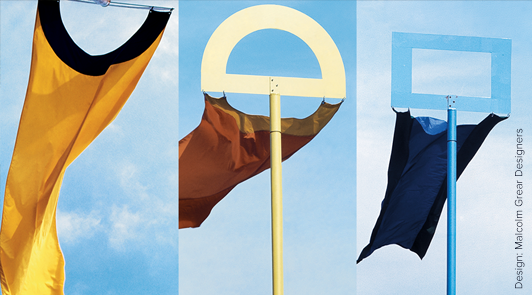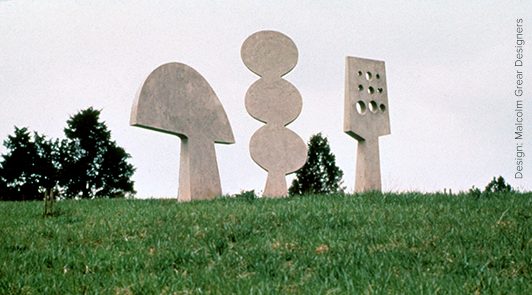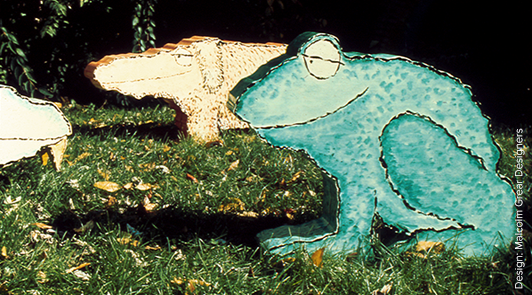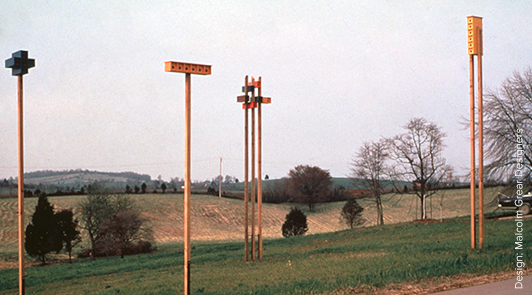It’s curious how the arc of one life can shape the arc of another. In the blink of an eye. And so it happened with Malcolm Grear’s design career and his influence on mine.
As a sophomore graphic design student at RISD, I was fascinated with Malcolm’s teaching and his professional work. I grew to deeply respect the big-hearted, sharp-witted, gregarious Kentuckian that he was. He could tell a story that could stay with somebody for a lifetime.
Which is what he did the day he gave our class a presentation on his corporate identity work. One image remains vivid in my memory: brightly colored banners sweeping across a brilliant blue sky, moored to the top of poles graced with similar geometric shapes. Malcolm enchanted us with the environmental design his studio had recently completed in 1972 for Oakwood Center, a residential mental health facility for children coming from rural Kentucky.
The main entrance was astonishingly, not a clinically sterile sign, but a capricious sculpture of three parts created by artist Hugh Townley, bold enough to tame the bureaucratic state officials into approving it. Everything was imaginative, kinesthetic, uplifting, and most of all designed to comfort and heal the kids. There were vegetable gardens, and terrariums with little creatures and plants from a small swamp nearby to be cared for; play structures built from hand-hewn logs to explore; and painted tractor seats to sit on awhile. Even the creatures sculpted by cartoonist, Ed Koren, were named by the children, who I envisioned became best friends with the dogs and frogs and snakes.
What I remember most was Malcolm sharing about the kids who were too disabled physically or mentally to leave their beds. For them, he created a wind sculpture and birdhouses placed outside their windows ”to draw their eyes skyward.” Those birdhouses provided sanctuary for martins—and delight for the kids who recognized them from back home. It was easy for Malcolm to design within the context of their culture. He simply had to reach back into his frugal childhood as a farm boy, and remember the spinning windmills and clever birdhouses made from Clorox bottles. Design came alive at Oakwood in what Malcolm called ”visual vitality.”
But it was way more than that. Those banners I remember? The children continue to make them. And as they cut and sew from the patterns that Malcolm designed, I bet this is the experience he wanted them to have:
“When your banners dance in the wind for all of us to see, know that we will hear you. We will hear you saying, ‘We belong here. In this healing shelter. On this soothing land. Here our spirits fill with hope. And we are free to love.'”
It’s Malcolm’s empathy that stays with me. And the outrageously creative ends he would go to dignify the lives of the people he designed for with equal parts emotion and reason. Then there’s his aversion to fences. Those kids at Oakwood never got fenced in, isolated, or shunned (as still happens today) even though the nearby community initially demanded it. No, they hadn’t reckoned on the transformative power of design wielded in the hands of a humble and humorous man named Malcolm Grear.
That one afternoon in Market House, the trajectory of my career was traced lightly across my future. For more than forty years now, I’ve been designing brands and pushing the boundaries of design. Recently, I founded the Sea Change Design Institute a growing nexus of change agents committed to finding solutions to critical economic, social, and environmental problems. This is our definition of design: the conscious planning and meaningful action that creates relationship with humanity, nature, spirit, and time. Seems like Malcolm knew this all along.
This tribute is part of the Malcolm Grear memorial event and exhibit at RISD held on October 7, 2017, which honors his contributions over more than half a century. You can learn more about the Oakwood Center in “Inside/Outside: From the Basics to the Practice of Design” showcasing the teaching and professional work of Malcolm Grear, renowned artist, design legend and founder of Malcolm Grear Designers.








hello[at]seachangedesign.com
+1.831.426.8026
Sea Change Design Institute
317 Arroyo Seco
Santa Cruz CA
95060 USA